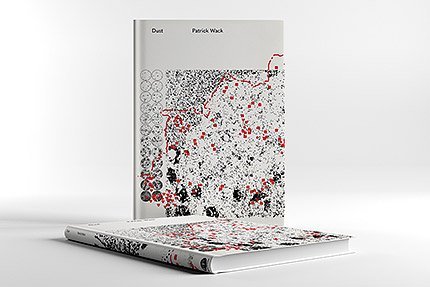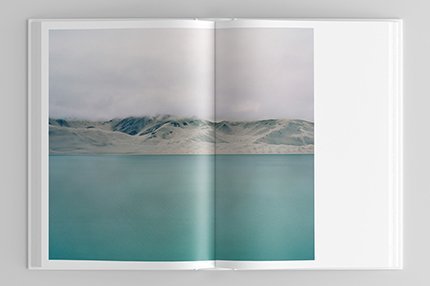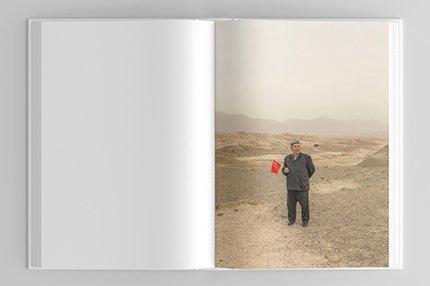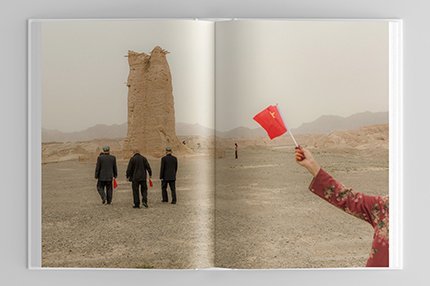Book Review: "Dust" by Patrick Wack
“One man’s west is forever another’s east; the romanticism of the pioneers underlies the despair of the colonized.”¹
The first image we see is of a sand-colored wall in the subdued light of morning or evening. It is in a state of dilapidation, exposed brickwork lines its crown, debris is piled around its foundation. On the face of the wall is a fresco reminiscent of Chinese shan shui hua paintings. It depicts a landscape rendered in delicate blue-green hues accented with gold-yellow foliage. The fresco's bucolic composition is interrupted by thinly trickled patterns of water stains and plaster-haloed pockmarks resembling small arms fire or hammer blows. The only clues as to when or where we might be is a piece of bright red trash below the fresco that appears to have Arabic script printed on it and some architectural elements illustrated in the fresco itself. It is an enticing and symbolic invitation to Patrick Wack's monograph DUST.
Released in October 2021, DUST is Wack's first photobook, but his photographic practice and decision of subject matter were years in the making. Originally from a suburb outside Paris, Wack made the ambitious decision to move to Shanghai in 2006 with aspirations of establishing himself as a commercial photographer. In 2016, after a decade of shooting commissions and numerous personal series, Wack made his first of several expeditions to the far northwestern Chinese region of Xinjiang. He describes his motivation to do so as a desire to document a historic moment of rapid modernization in the region and as an examination of contemporary frontier romanticism. Traveling throughout Xinjiang in a series of road trips, Wack set out to photographically illustrate a region with a landscape and culture that contrasted with his impressions of highly developed eastern China that was being subjected to rapid development and change by the central Chinese government:
“The starting point was my desire to work in a region of China that did not look like China. I wanted to convey images that would shake the established visual stereotypes of the Chinese world… to make sense photographically of a region more than twice the size of France and home of many different minorities, most of them of Central-Asian ancestry and Muslim confession”²
DUST is composed of two collections of photographs combined into a remarkably unified whole. The first, a series titled Out West, features images from Wack's 2016-2017 travels through Xinjiang. To capture all the photographs in Out West, Wack deployed a collection of high-quality medium format film cameras (Mamiya 7, Mamiya 6, Contax 645) loaded with color negative film stock (primarily Kodak Portra). The resulting photographs represent an impressive undertaking that is vast in its scope and ambition. Over the course of roughly a calendar year, Wack managed to travel to the far edges of Xinjiang as well as explore its major cities. The subject matter in his compositions ranges from seemingly endless landscapes that read equal parts inhospitable and sublime to portraiture that feels contemplative and intimate.
With such an expansive physical landscape and complicated socio-political environment explored in DUST, the editing and sequencing of photographs in the Out West portion of the book artfully weaves depictions of Turkic peoples who have traditionally inhabited the region with the more recent Han Chinese arrivals. Scenes in Wack's photographs take the viewer from bastions of Uyghur culture–the cities Hotan and Kashgar–to industrial hydrocarbon exploration by Han Chinese workers in the remote Taklamakan Desert. It is a stimulating and beautiful collection of images that contrasts tradition with modernity, nature with industry, the serious with the absurd. Present throughout is a disquieting power imbalance between the Turkic ethnic groups of Xinjiang and the looming People's Republic of China government.
The second series of photographs in DUST is called The Night is Thick. This section of the book is poignant, feeling like a somber epilogue to Out West. Originally, Wack did not plan to return to Xinjiang to capture more photographs. However, reports of shocking abuses against muslim ethnic minorities, Uyghurs in particular, by the Chinese government compelled him to return:
“I had left a territory under surveillance only to return to find an open-air prison. The landscape had changed; it had been stripped of the slightest religious or cultural symbol. The mosques were locked shut, the women divested of their veils, the domes and the crescents had vanished, the Uyghur villages seemed uninhabited, and bouquets of surveillance cameras had blossomed everywhere.”³
If Out West is a musing, somewhat ambivalent guided road trip through an unfamiliar yet beautiful landscape at the crossroads of old and new, The Night is Thick is a resolute moral statement. The image that introduces the second section of the DUST is far less ambiguous and much grimmer than the worn fresco at the beginning of the book: a half-demolished Uyghur burial ground stands in the foreground while rows of new, selfsame apartment structures stretch across the horizon. The images that follow depict a more forceful form of subjugation brought down upon Xinjiang by the Chinese government: the pervasive security state that dominates Xinjiang–a woman staring directly into the lens, clutching her state ID card; the contrived and imposed PRC nationalism–Chinese flags, lanterns, and scrolls festooned overhead in the markets and bazaars that were covered in Arabic-script signage just a few years prior; the culture of local ethnic groups turned into a token–Han Chinese tourists take photos at "ethno parks" while staff are dressed in traditional Turkic garb. It is a darker portrayal of the region that had initially held the romantic allure for Wack, but the moral clarity in The Night is Thick is commensurate with the reality of present-day Xinjiang.
DUST is not just a collection of timely, powerful photographs, it contains four essays and bold graphic design elements that provide rich context for the book's images. In addition to the preface, written by Wack, two essays written by academics specializing in Chinese studies (Rémi Castets and Dru C. Gladney) are interspersed in the Out West section of the book. The final essay in the book, written by journalist Brice Pedroletti, introduces The Night is Thick series. While pages that feature photographs are devoid of any text or design elements, the essays, and even plate list, are heavily overlaid with graphics suggestive of the techno-dystopian surveillance state present in Xinjiang. These texts and the accompanying graphic design create an intentionally dissonant experience that adds a layered and nuanced experience to the book.
Wack’s preface is a concise and stirring summary of the artistic and societal themes that follow in the book's images and essays, along with an expository outline of contemporary Chinese expansionism and the oppression of ethnic and religious minorities in Xinjiang. The contributions by Castets and Gladney appear in the Out West section of the book, and provide historical and sociological context for the region now known as Xinjiang and the peoples who have lived there over time. Situated just before the photographs that make up The Night is Thick, Pedroletti’s essay serves as the transitional element between the two series in DUST. It is by far the most visceral and stirring text in the book, giving vivid texture to the widespread repression present in Xinjiang and the abuses executed by the Chinese government, including profiles and interview excerpts with individuals who managed to flee China after being imprisoned or otherwise witnessing atrocities. While many readers might know of the oppression of Uyghurs by the Chinese government through reporting in major media outlets, Pedroletti's text is essential context for viewing all the images in DUST, especially The Night is Thick portion. As Wack pointed out in an interview with Geographical magazine, "photojournalists don’t have access to the camps or many signs of repression. Plus, you’re putting [local] people in danger if you’re trying to talk to them."
DUST presents moral and factual clarity that feels refreshing in the space of contemporary art-documentary photography projects. At times, the critical discourse within contemporary Western cultures gives the impression that concepts of moral certitude, objective description of material events, and once agreed upon narratives should be treated as kindling for a cleansing conflagration of old ways, attitudes, and myths. However, recent and ongoing atrocities in the far northwestern Chinese region of Xinjiang bring into clear relief the categories of actions that are inhumane, unjust, and unacceptable for any culture in any place.
Overall, there is a deft balance between the contemporary photo documentary inclination to be highly personal and oblique with a clear moral and political statement reminiscent of modernist documentary and photojournalism. This balance is achieved through the relationship of photography, supporting text, and graphic design. Since the essays are woven throughout the book, the transition from poetic imagery to text with bold graphics can feel somewhat jarring at times, but these sharp transitions help to break up the digestion of beautiful, poignant images and remind the reader of the context in which Wack captured the images. The full layout of the book highlights the often discordant relationship between muddied personal experience and larger socio-political realities. Wack has expressed doubt as to whether his work will have any material impact on the abuses taking place in Xinjiang. However, the photographs in DUST certainly offer a rare and moving glimpse into a part of the world obscured by distance and secrecy that ought to stir the conscience of any reader.




Dust by Patrick Wack
Format: Hardcover
Pages: 176 pages
Size: 24 x 32 cm
Language: English / French
Release Date: October 2021
Photographs: Patrick Wack
Texts: Rémi Castets, Dru C. Gladney,
Brice Pedroletti, and Patrick Wack
Introduction: Andria Spring and Julien Syrac.
Design: João Lineu
ISBN : 978-2-492696-02-2
Available for purchase via André Frère Éditions
REFRENCES
¹Preface to Dust, written by Patrick Wack
²"Interview Patrick Wack" from inframe.fr, 2020
³Preface to Dust, written by Patrick Wack
ABOUT THE REVIEWER
Joseph Webb is a photographer based in Orange County, California. Originally from southern Oregon, he relocated to Portland to attend Pacific Northwest College of Art, earning a BFA in General Fine Arts in 2011. Since finishing college, he has worked primarily as a staff photographer and art director at several large fashion and retail brands. While his vocation involves a great deal of work in digital imaging processes, his personal artistic practice consists largely of documentary work and is strictly analog. In 2020, he established a color darkroom printing studio, Myth Editions (Instagram), which collaborates with film photographers to create and publish small runs of hand-printed photographs.
Connect with Joseph Webb via his Website and his personal Instagram and via Myth Editions!










Shadow Gather’s photos unveil nightlife’s raw, electric energy as spaces of defiant authenticity. Her Meow Wolf exhibition elevates marginalized stories, embracing imperfections as vital truths. Each image is a protest against sanitization, celebrating unguarded moments of liberation.